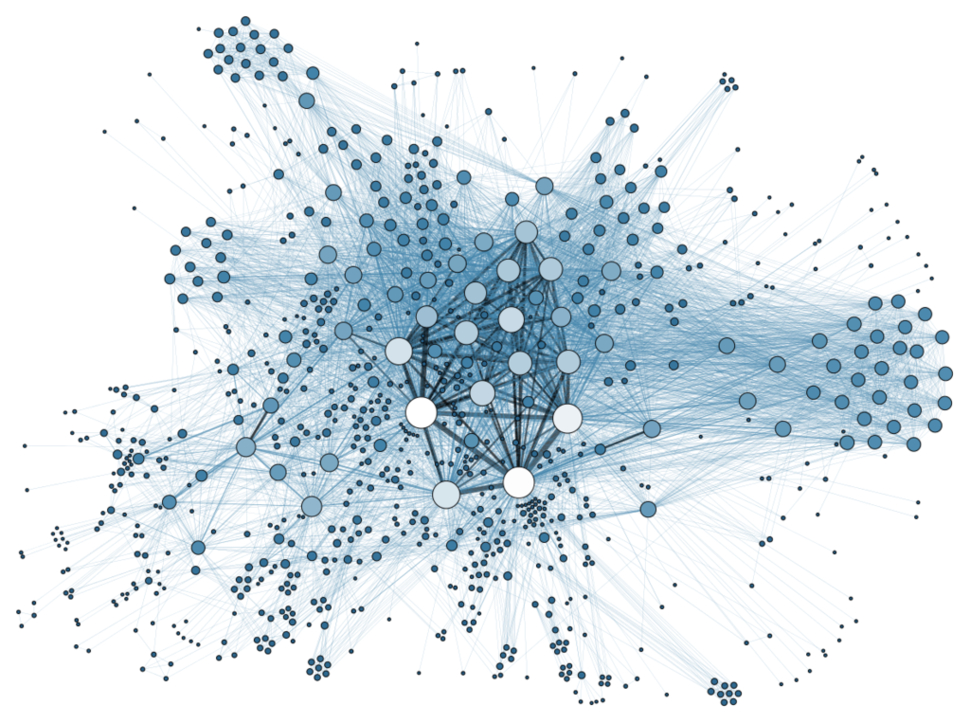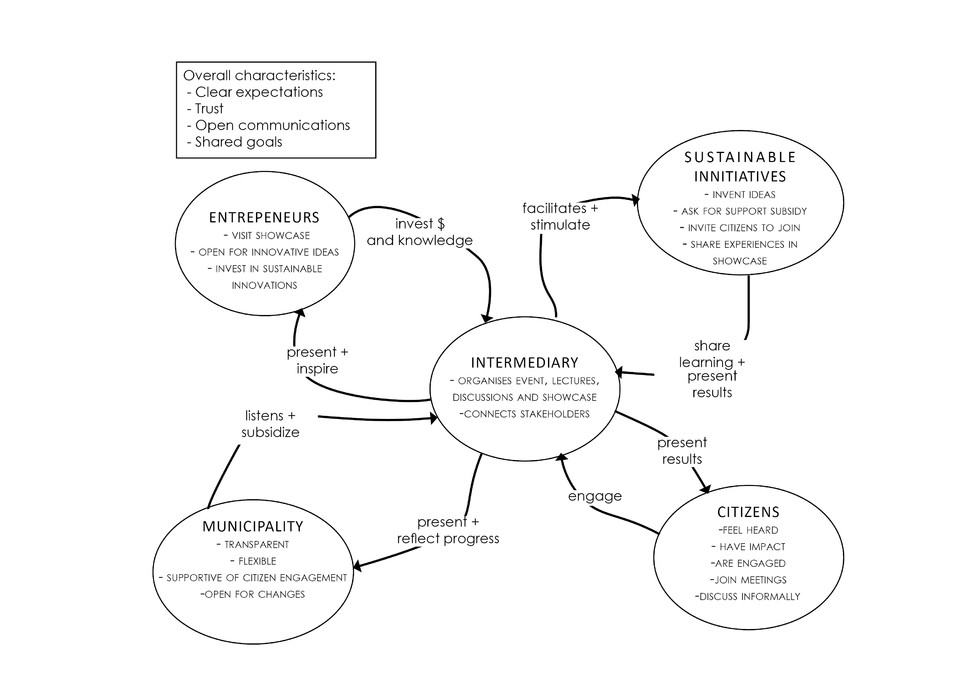Social Network Analysis Visualization by Martin Grandjean. On November 2013, this file was licensed with the Creative Commons License CC BY-SA 3.0.
This section describes the future sub-system, when the vision we propose is achieved, from the perspective of presence. We do this by drawing a new diagram with the stakeholders and their new interactions. Secondly, we recall the YUTPA framework and identify how these values will be constituted in the future sub-system.
Stakeholders and their interactions
In the future sub-system, an extra important stakeholder has been arised: next to the municipality, citizens, entrepreneurs and sustainable initiatives, the newly introduced stakeholder is the intermediary. This person, organisation or social construction functions as the facilitator, stimulator and connector between the other four stakeholders.
The goal of the intermediary is to bring together stakeholders to advance on their journey in reaching the sustainable goals through innovation, as formulated by the municipality (in discussion with citizens). Specifically, the intermediary organizes ‘Texel Innoveert’, which is a program that stimulates sustainable innovation ideas to be presented. The most popular ideas are subsidized and use the ‘experimentation space’ to work on improving the innovation. All innovative projects are presented in a showcase, which is both a yearly event in the form of a festival or market, and a building in which expositions on sustainable innovations form an attractive knowledge-activity for both citizens, schools and visitors of Texel.
The interaction between all stakeholders is shown in the picture below. Clearly, communication with the municipality has become two-way instead of one-way. This means the municipality has become transparent in the goals and activities and they are open for input of citizens. Discussions are organized when new plans are being developed, to evaluate previous projects or when other input is welcome. Citizens, entrepreneurs, sustainable initiatives and the intermediary join these discussion to give their critical and constructive opinion on how the municipality should act. These discussions are attended by many, because the municipality shows afterwards how they have used the input in their work.
This interaction makes citizens feel heard and feel they have an impact on their community. They feel comfortable to join meetings and actively engage in discussions with the municipality, in activities organised around their sustainable goals or in sustainable experiments. The topic of sustainability lives among the people and they talk about it in informal settings as well.
The interactions with the intermediary are always two-way. With the municipality he discusses the sustainable goals, rules and regulations and available resources. He facilitates innovation for sustainable initiatives, by providing information, connecting them with resources and knowing the right people. Citizens are presented the activities by ‘Texel Innoveert’ and in return feel engaged. Finally, entrepreneurs are presented the new innovations, which inspire them and might cause them to invest in certain ideas.
Rules and regulations have changed compared to the current state, during a step by step process. Over time, the government has listened which regulations limit innovative ideas. With an open mind, they have investigated which of these regulations should be adjusted, in order to optimally achieve their goals. This gave innovations more space, until they came accross the next obstacle. In steps and within their power, the municipality has provided innovators with a realistic set of rules and regulations.
Subsidies are available for innovative ideas. All innovation ideas are submitted to the municipality (or the intermediary) who makes a pre-selection. During the showcase-event, the public can vote for the ideas they like most, making sure the projects are appreciated by the community. Subsidies are provided for the winning ideas, which are meant to start the innovation process and make a realisitic estimate of the potential. This is done by granting the high potential innovation ideas some space in the ‘experimentation space’. Nextly, entrepreneurs of knowledge institutes are invited to invest in the innovation. When this is not done, the municipality reviews the innovation and may decide to subsidize more, but there is a selection to it.
The diagram below describes the stakeholders and their interaction.
In our proposed pathways, the whole of the intermediary is made by our technological solutions. In both of them, the technical solution acts as an intermediary, connecting innovators to other actors.
The Texel inoveert event and the Sustainaversity expose the inovations made in Texel to a wider public, raising the chances of actors to communicate and contribute to each other. In addition, it also activates and engages the other actors to join and interact with the sustainable innovations.
The more these initiatives grow, more awareness is raised to them, giving their demands a higher priority in the municipality goals and on the daily life of citizens.
YUTPA framework
In section 2.2 we described the daily life from the perspective of presence by using the YUTPA framework. Using this description, we formulated ambitions on which aspects of presence had most potential for being addressed. Here, we reflect whether our future vision and future sub-system uses this potential.
Current situation
The high potential aspects from the YUTPA framework in the current situation are, as described in section 2.2, situated agency (people feel they can make in change in their environment), synchronizing performance (a culture in which people think and behave in a comparable way) and environmental impact (an environment in which people are positively stimulated to perform desired behaviour).
To cite ourselves, these three aspects connect to each other strongly. “Improved synchronizing performance can create a culture in which people think alike about sustainability. This creates an environment in which innovation is stimulated (environmental impact grows). This again supports closing the gap between ‘willing to change’ and ‘able to change’; situated agency, which can be enhanced by other measures as well.”
Future situation
In the future sub-system, the intermediary (Texel Inoveert or Sustainaversity) and renewed interactions between all stakeholders impact the aspects of the YUTPA framework. Here, we reflect on the impact on the three potential improvements, instead of reviewing all aspects of the framework. In the section 4.4 we make a brief consideration on how each of these aspects would be affected by each of the pathways.
First of all, synchronizing performance has increased for citizens by the increased transparency of the municipality and by the increased interaction among all stakeholders. This causes people to know what is expected from them and what other people to do come into action. It is now much easier for citizens to adjust their behaviour and be engaged in the way they personally prefer.
This synchronized behaviour contributes to an increased environmental impact. Within the community, innovation is a topic of conversation and it is actively stimulated by the municipality and the intermediary. Even uninterested people hear about the developments and hear stories from their friends, family and neighbors. This does not make everybody engaged, but at least it creates the opportunity for everybody to engage for whatever interests them.
Lastly, situated agency has improved strongly; the gap between ‘willing to change’ and ‘able to change’ became smaller by transparent communication, shared expectations and more room for taking action. This is certainly caused by increased synchronizing behaviour and environmental impact, but also by the role and activities organized by the intermediary, such as Texel Innoveert. This program invites for action and facilitates the innovation process, making it much easier to dive into a new project than before. Apart from that, it creates and provides connections between people who can work together, contributing to the second step of our vision (Texelaars have connections to acquire the required resources).
In short, we believe that our solution solves the challenges of presence regarding the three above mentioned aspects. We did not re-investigate the other aspects of the YUTPA framework, because we prefer to focus on a specific topic on which we can make an impact.

